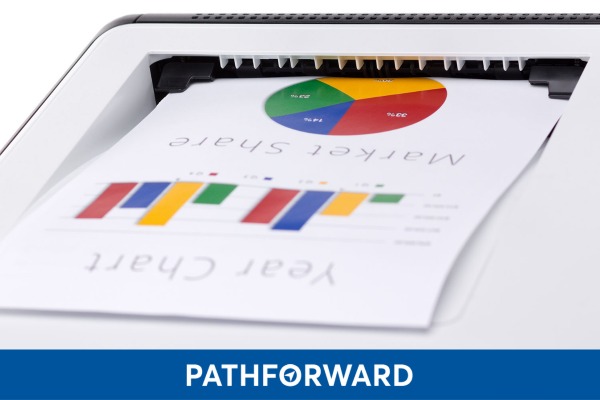Because print can be a pain and very expensive at times, it requires our attention. To help, we put together the five most important metrics that define the “health” of any organization’s office print environment so you can see where your organization can save money on enterprise printing:
- Pages per user per month;
- Pages per device per month;
- Percent of color usage;
- Percent of pages printed duplex;
- Percent of locally attached devices

Four of the five are related to user behavior or preference; however, pages per device have some relationship to the other metrics but tie back more directly to sourcing habits of over-buying, being over-sold, or both.
With four metrics aligning to user behavior, it’s important to understand users and the print choices they make because devices don’t print, people do. If an organization is not managing people, it is not managing print. But, why do people print? People only print for two reasons: because they want to out of convenience, habit or preference or because they have to due to processes or regulations.
In these environments, paying attention to how people print will help you make intelligent decisions that can benefit the print health of the organization like reducing paper consumption, lowering costs of enterprise print, or better enterprise print management. We believe that employees will do the right thing when they know what that is. Essential to this is having a print policy in place, effective communication, proper training, and working closely with the largest “cost causers” or “outliers”. When you work closely and listen to those that print the most (“cost causers” or “outliers”), it can also lead to quickly identifying paper-based processes and candidates for digital transformation.
At the same time, equipping decision-makers with the stated print policy that includes average volume per device along with a design plan to help guide the placement of devices, especially (way fewer) color devices, is also essential. The design plan is also driven by cost per page per building (or department) guidelines to ensure the right device is placed in the right location for a specific building (or department).
Let’s now closely examine each of the five key metrics.
1. Pages per User per Month
This first metric quickly illustrates the relationship end users have with paper and/or to what extent paper is part of the fabric of the organization. A high number here indicates cost savings are material and with the right policy, technology, communications, and reporting the “want to” print will very quickly go away. The “have to” print requires more work, more paper trails, more interviews to understand why paper is still being used and what can be done to go digital.
When we work with a client, we target 40% total volume reduction within the first 3 years and we’ve been extremely successful at achieving this goal. If COVID has taught us anything in the print world, it is this: we can live, we can learn, we can grade, and we can sign important documents without paper. Making devices less accessible will help with this metric, too, especially with #3 below.

2. Pages per Device
This metric signals how efficiently and cost-effectively devices have been deployed, measuring utilization rates that play a major role in the cost per page of every device. The lower the pages per device the greater the potential for a substantial cost reduction. And the largest cost-avoidance benefit possible.
We have yet to have the experience of working with a client that doesn’t have too many devices. For this reason, the very first request we make is to stop buying any more devices. Multi-function devices (MFDs) that run less than 1,000 pages per month (in higher ed) or 2,000 pages per month (everywhere else) and single-function printers (SFPs) that print less than 500 pages per month (in Higher ed) or 1,000 pages per month (everywhere else) are underutilized and costing the organization.
Here’s the quick math for a 50 page per minute MFD with a base + click plan, and a click charge of $.005: an MFD that is being leased for $100/month but only running 1,000 pages/month will cost $105/month or $.105 or 10 ½ cents per page. The exact same MFD that has been placed more appropriately and produced 7,500 pages per month will cost $137.50/month, or $.01375 per page, over 86.9% lower. Whenever an organization has a fixed cost component, be it a lease or an amortization, usage is directly correlated to cost per unit. When we design a fleet, we target 5,000 pages per device per month (for Higher Education) and 7,500 pages per device per month (everywhere else). We target an effective TCO rate of less than $.0167 across all SFPs and MFDs making use of existing devices where practicable, combined with new devices, mostly MFDs. We also design for where volume will be, not where it was pre-COVID. This is a very important concept as many organizations just do a like-for-like and end up with too many devices running too few pages per device per month.
3. Percent of Color Usage
Costing as much as 10x the cost of a mono printed page, these pages are the most expensive for any organization. Making color volume reduction a priority is among the most lucrative savings available. The print industry knows that the more devices they place, the more pages will be generated. Likewise, the more color devices, the more color pages, and the more cost to the organization. Even a modest 15% color percentage, can easily translate to more than 50% of the total cost for an organization. Here’s the reality, the vast majority of print in the office never leaves the office, with most going to the trash. Why insist on printing PowerPoint slides when projectors are widely available in most meeting rooms. We have one client that prohibited the use of handouts if there was a projector available. Another client mimicked this with their own poster campaign that computed the cost of a typical PowerPoint deck to its most profitable product and how little changes can make a huge difference.

4. Percent of Pages Duplex Printed
Only since COVID has this metric been included in the top 5. Due to COVID and demand exceeding supply (from paper mills shutting down to the intense competition for pulp and the packaging explosion), the cost of a sheet of paper is now more expensive than a cost of a click. Duplexing is such a simple practice that not only rewards the cost line but also contributes to the well-being of the environment.
5. Percent of Locally Attached Devices
These devices are those not on the network but connected to a PC, Mac, or whatever using a USB or direct connection. While they may only average 150 pages per month, they are more expensive than color printing. This is due to the cost of supplies, often ink-jets (the most expensive) being more costly and on average, locally attached devices print roughly 50% more color than networked MFDs. This combination makes locally attached devices the most expensive asset in the office, or at home. It adds to the expense as locally attached devices take pages away from MFDs (the most economical choice). Two things need to occur to remove these devices from the office: establish a print policy that encourages greater device utilization and eliminates locally attached devices, and deploy pull printing or secure release technology to address the user need for private or confidential printing where a print job is not released until the owner is present in front of the device with their credentials. Plus, every locally attached device removed will fully fund the implementation of secure print that is enabled with a card.
What does all this mean for your organization?
The one investment you can make to dramatically improve the 5 metrics is to secure devices and move towards authentication. Here’s how:
- When users know that they have to badge in to copy, print, scan, and fax, there is a psychological impact that results in users not printing as much because they are being closely monitored. We have witnessed first-hand print behavior being impacted by a reduction of print volume by 65% – with an average reduction of 25-40%. This reduction comes mostly from the “want to” print.
- By introducing secure print, or badge authentication, there is no need for a personal or locally attached device. Cost is saved but also shifts print volume to MFDs increasing their utilization rates and reducing the corresponding cost per click.
- With less print comes less color, especially from locally attached devices so costs can be dramatically improved. Less print also translates to less paper and less waste.
- Securing devices creates a virtual 100% uptime environment allowing devices to print on any available device creating new end-user flexibility and satisfaction. From a sourcing perspective, why pay for 4-hour or same-day service when there will always be devices that are available to print to.
- The most secure, the most sustainable, the most efficient, and the most cost-effective page is the page never printed. Securing devices results in fewer pages.
Take The First Step
If you’re not thinking about your print strategy holistically, you may be paying millions of dollars more every year than needed. However, developing a strategy and utilization of fixed assets can lead to an enterprise saving between 35-65%.
If you are interested in these types of savings and driving bottom-line impact, the model below is how and what PathForward does in helping organizations like yours find the best-tailored strategy for their goals, priorities, and requirements.
We have helped organizations like yours save over $750M.
